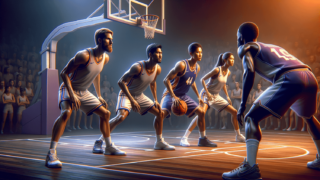
How to Develop a Basketball Post-Season Training Program?
Written by: Basketball Universe
Last updated:

When the final buzzer of the season sounds, many basketball players find themselves eagerly anticipating the off-season, ready to hang up their sneakers for a well-deserved break. However, the post-season is an opportune time to level up your game and outshine your rivals when it matters most. In this blog post, we’ll delve into the exciting world of post-season training programs, providing you with the tips, tricks, and strategies you need to create a tailored program that accelerates your skill development, elevates your physical conditioning, and leaves you poised to make a big splash when the next season rolls around. So lace up your sneakers, grab a basketball, and let’s get started on elevating your game to new heights!
How to Develop a Basketball Post-Season Training Program?
To develop a basketball post-season training program, start by setting specific and measurable goals for skill development and physical conditioning. Identify your weaknesses and strengths, establish a timeline for progress, and include a variety of workouts targeting different areas of your game. Incorporate strength training, agility drills, shooting practice, and ball handling exercises into your program. Balance on-court training with off-court conditioning and recovery activities like stretching and rest, and consider working with a coach or trainer to ensure proper technique, monitor your progress, and provide guidance.
Setting the Stage: Establish Your Post-Season Goals
The first step in designing an effective post-season training program is to set clear and achievable goals. These targets will guide your training regimen and maintain your motivation throughout the off-season. To get started, reflect on your recent performance, areas needing improvement, and your overall ambitions as a basketball player. Consider both your on-court skills and off-court conditioning when setting these objectives.
On-Court Skill Development
Identify the aspects of your game that need the most work, such as shooting accuracy, ball handling, defense, or court vision. Set realistic but challenging goals for each skill, such as improving your free throw percentage by 10% or increasing your assists per game by 2. Keep these objectives in mind as you build your training program.
Off-Court Conditioning
Athleticism and overall physical fitness are critical to your success on the court. Identify specific aspects of your conditioning that can contribute to improved performance, such as increasing your vertical jump, building muscle mass, or improving endurance. Use these goals to inform your strength and conditioning workouts.
Designing a Comprehensive Training Program
With your goals in place, it’s time to shift your focus to creating a structured, well-rounded training program that targets your specific needs. A successful post-season training regimen should include a balance of on-court skill development, off-court conditioning, and recovery activities. We’ll explore each of these categories in more depth below.
On-Court Skill Drills
Developing your basketball skills requires dedicated practice and repetition. Integrate relevant drills into your training program to target specific improvements, such as shooting, ball handling, defensive techniques, or court vision. Here are some drills to consider:
- Shooting: Practice various shots, including layups, jump shots, three-pointers, and free throws. Incorporate shots from different areas of the court and simulate game situations to enhance your accuracy and confidence.
- Ball Handling: Improve your dribbling and control through cone drills, two-ball dribbling exercises, and wall ball drills. Improving your ability to handle the ball with both hands will make you an even more effective player on the court.
- Defense: Develop your defensive skills by practicing various stances, slides, and one-on-one drills. Strengthen your footwork and focus on lateral movement to increase your agility and ability to stay with your opponent.
- Court Vision: Enhance your ability to see and read the court by participating in small-sided games or scrimmages. The more you play in these settings, the better you’ll become at recognizing openings and making split-second decisions.
Off-Court Conditioning
Boost your athleticism and overall conditioning with targeted workouts designed to improve your strength, speed, agility, and endurance. Use a combination of the following exercises to accomplish your specific goals:
- Strength Training: Build muscle mass and increase your power with weightlifting exercises, such as squats, deadlifts, lunges, and bench presses. A strong body helps you perform at a higher level and reduces the risk of injury.
- Speed and Agility: Incorporate sprints, plyometrics, and agility ladder drills into your routine to boost your speed, explosiveness, and quickness on the court.
- Endurance: Improve your cardiovascular fitness through steady-state aerobic exercises like jogging or cycling, or high-intensity interval training (HIIT) to develop the stamina needed for fast-paced games.
Recovery and Maintenance
A successful training program doesn’t end with on-court drills and off-court conditioning. Prioritizing recovery and maintenance is crucial to ensuring that your body remains healthy and injury-free. Implement the following recovery strategies:
- Stretching: Incorporate flexibility exercises, such as dynamic stretching before workouts and static stretching post-workout, to help your muscles recover and maintain optimal range of motion.
- Rest and Sleep: Allow your body sufficient time to recover by prioritizing proper sleep and scheduling rest days to avoid over-training and potential injuries.
- Nutrition: Fuel your body with a balanced diet that provides the necessary nutrients to maximize performance and recovery. Consider consulting with a nutritionist to develop personalized meal plans catered to your specific needs and goals.
Monitor Progress and Adjust your Training Program
To ensure the effectiveness of your post-season training program, it’s essential to regularly assess your progress and make adjustments as necessary. Establish a schedule for tracking your performance and measuring your gains. Here are some tips to help you track your progress:
- Keep a Training Journal: Write down your workouts, statistical improvements, and other successes during the off-season. Regularly reviewing your accomplishments will help you to stay motivated and maintain a clear focus on your goals.
- Measure Performance Metrics: Track key metrics, such as vertical jump height, sprint times, or lifting capacities, to monitor your progress and provide measurable benchmarks for success.
- Record Game Performance: Capture game footage during scrimmages or pick-up games to analyze your on-court performance, identify areas for improvement, and assess your progress towards your goals.
When monitoring your progress, remember to remain open-minded and adaptable. If you’re not making the gains you’d hoped, don’t be afraid to tweak your training program, seek outside expertise, or collaborate with coaches and trainers to maximize your growth potential.
Maximizing Success: Tips for an Effective Post-Season
With your comprehensive post-season training program in place, it’s time to get to work. Here are a few tips to maximize your success and make the most out of the basketball off-season:
- Stay consistent and disciplined: Follow your training regimen and maintain your focus on your established goals. If you consistently put in the work, you’re more likely to achieve your desired results.
- Seek expert guidance: Participate in basketball clinics, camps, or training sessions with experienced coaches and trainers who can provide valuable insight and advice. Their expertise can help you refine your technique and fast-track your progress.
- Group training: Work out with teammates or other athletes who share similar goals. Training with others can foster camaraderie, friendly competition, and much-needed support during the off-season.
- Embrace failure and perseverance: Improving your basketball skills is a long-term process that won’t always be smooth sailing. Embrace setbacks and learn from your mistakes to emerge as a better player when the next season begins.
By following these guidelines, staying committed to your goals, and embracing the off-season as a valuable period for self-improvement, you’ll be well on your way to elevating your game and reaching new heights in the world of basketball.
Finding Balance: Periodization and Training Phases
Designing a successful basketball post-season training program requires a well-thought-out balance of exercises, intensity, and recovery. To achieve this, many athletes and coaches use periodization—breaking the off-season into smaller, manageable phases. Each phase focuses on specific goals and progresses as you become more skilled and fit for the new season.
Periodization offers several benefits, including improved performance, better workout recovery, and reduced injuries. Below, we outline a sample periodization approach and the accompanying training phases.
Transition Phase
The transition phase helps your body recover from the rigors of the previous basketball season while maintaining a base level of fitness. Lasting around 1-2 weeks, this phase involves active rest with low-intensity, enjoyable activities like swimming, light jogging, or yoga. This variety allows your body to recuperate and sets the stage for the more intense workout phases that follow.
General Preparation Phase
The general preparation phase is where you start focusing on building strength, speed, endurance, and improving overall athletic performance. This phase lasts 4-6 weeks and usually involves a combination of resistance training, aerobic exercises, and skill-building drills. Training volume is increased, and the focus is on creating a solid athletic foundation that can be refined in the later stages of the post-season program.
Specific Preparation Phase
In the specific preparation phase, you’ll begin honing your basketball skills and translating the physical gains from the general preparation phase into on-court success. Lasting around 4-6 weeks, this phase should include more basketball-specific drills, such as shooting, ball handling, defense, and court vision. Additionally, incorporate high-intensity basketball conditioning workouts and scrimmages to simulate game-like situations.
Pre-Season Phase
The pre-season phase serves as the final leg of your post-season training program. With the basketball season now fast approaching, this 3-4 week phase is designed to peak your performance, focusing primarily on basketball-specific skill development while maintaining your hard-earned physical conditioning. Prioritize intense, sports-specific training—individual drills and team practices—to sharpen your skills and prepare for the upcoming season.
Supplementing Your Training Program
While your post-season training program should be the primary focus of your off-season development, several supplemental activities can further enhance your overall performance. Keep in mind that these should complement, not replace, your main training program.
Mental Training
Sport psychology plays an essential role in basketball performance. Integrate mental training exercises, such as visualization, goal-setting, and positive self-talk, to improve focus, confidence, and mental toughness. By honing mental skills alongside physical abilities, you’ll be better prepared for high-pressure game situations.
Balance and Stability
Well-developed balance and stability are crucial for agility, coordination, and injury prevention in basketball players. Incorporate exercises such as single-leg balance drills, balance board training, and stability ball exercises to enhance overall balance.
Mobility and Flexibility
Improving your mobility and flexibility can lead to better on-court movement, decreased muscle imbalances, and reduced injury risk. Yoga, Pilates, and functional training methods focus on enhancing range of motion, core strength, and joint stability, providing valuable tools to complement your basketball-specific training program.
By incorporating periodization and supplementary training into your basketball post-season program, you’ll optimize skill development, physical conditioning, and recovery, ensuring that you return to the court better prepared than ever for the upcoming season.
Frequently Asked Questions (FAQs)
As you embark on creating a basketball post-season training program, you may have some questions along the way. We’ve compiled a list of the most common inquiries along with brief explanations to help clarify any uncertainties and guide your journey to basketball success.
1. How long should my post-season training program last?
A typical post-season training program lasts between 12-20 weeks, with several phases focusing on different aspects of your journey—from recovery to skill development and conditioning. Keep in mind that proper rest and recovery are essential for optimal performance, so allow sufficient time to recuperate between phases.
2. How often should I work out during the off-season?
During the off-season, aim to work out at least 4-6 days per week—a combination of on-court skill development, off-court conditioning, and recovery activities. Be sure to schedule rest days for your body to fully recover and minimize the risk of overtraining or injury.
3. Can I still play other sports during my basketball post-season training program?
Participating in other sports during the basketball post-season can provide physical, mental, and social benefits, particularly during the transition phase. However, as your off-season training progresses, prioritize your basketball program to ensure you’re effectively developing the skills needed for the upcoming season.
4. How can I tell if my training program is working?
Regularly assess your progress by tracking key performance metrics, keeping a training journal, and recording game footage. If you notice consistent improvement in your skills, conditioning, and overall performance, your training program is likely effective. Remain adaptable and tweak your regimen as needed.
5. Is it necessary to work with a professional trainer or coach?
While you can develop a post-season training program independently, working with a professional trainer or coach can provide valuable insight, guidance, and motivation. Trainers and coaches offer specialized expertise and individualized feedback, helping you refine your technique and accelerate your progress.
6. How important is nutrition during my off-season training?
Nutrition plays a vital role in fueling your body for training, recovery, and overall performance. Maintain a balanced diet that supplies the necessary nutrients (macros and micros) and meets your energy requirements. Consulting with a nutritionist or dietitian can help you create personalized meal plans tailored to your goals.
7. Should I include weightlifting in my off-season training program?
Yes, weightlifting is an essential component of any comprehensive post-season training program. Incorporate a variety of strength-building exercises to improve power, reduce injury risk, and enhance on-court performance. Schedule weightlifting sessions 2-3 times per week during the general preparation phase.
8. How important is rest and recovery in my post-season training program?
Rest and recovery are crucial to maintaining optimal performance, avoiding injuries, and promoting progress. Schedule regular rest days within your training weeks, allocate time for stretching and mobility work, and prioritize high-quality sleep each night to ensure your body fully recovers.
9. Can I focus on improving only one skill during my off-season training program?
While it’s crucial to work on your weaknesses, a well-rounded post-season training program should cover all aspects of your game. Balance your training by incorporating drills that target shooting, ball handling, defense, and court vision, in addition to strength and conditioning exercises.
10. Is it better to train alone or with a team/group during the off-season?
Both individual and group training have their unique advantages. Individual training grants the freedom to focus on personal weaknesses, while group sessions foster camaraderie and competition, simulating game-like situations. Ideally, include a mix of both solo and group activities to maximize your off-season gains.
Featured Posts
- No pillar pages found.





